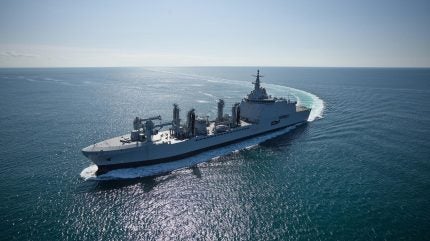
French shipbuilder, Chantier de l’Atlantique, has launched the French Navy’s second Logistics Support Ship (LSS) – the Jacques Stosskoph – into the water for the first time according to an update on 13 September 2024.
LSSs are interoperable double-hull auxiliary ships that abide by current environment regulations. The ships perform two uses: military operations and responding to civilian crises.
The vessel is capable of supporting multiple missions, ranging from naval task force to headquarters afloat operations, providing medical support and transporting naval and aviation fuel, fresh water, ammunition, lubricating oil, food, spares and 20-foot ISO containers.
LSS programme
Under the management of Europe’s Organisation for Joint Armament Cooperation (OCCAR), the LSS programme replaces legacy tankers in the French and Italian navies.
Currently, the French Navy still operate two Durance-class replenishment oilers that were first acquired in 1976. Similarly, the Italian Navy also deploy numerous auxiliary vessels that go back to 1970s and 1980s, such as the Stromboli-class oilers.
Notably, Brazil also has a vested interest in the European programme with its ‘observer status’, allowing them to participate in the programme as its own existing auxiliary platforms are in a similar legacy state.
Italy originally ordered two ships with an option for a third as the sole consumer when the contract was first established in 2015, however France subsequently joined in January 2019 with an order for four vessels.
Currently, the Jacques Stosskopf is the second French LSS after the first of the class, the Jacques Chevallier, which was delivered in 2023. This second ship also comes after Italy’s first LSS, the Atlante.
For France, the LSS fleet is designated the Force Supply Vessel (BRF) fleet; three more LSS (including the Jacques Stosskopf) will be delivered until 2029.
The keel for France’s BRF 2 was laid in December 2022 – 22 months after the keel laying of her eslder sistser, the Jacques Chevallier.
BRF Jacques Stosskopf
During the latest ceremony, OCCAR director Joachim Sucker mentioned the BRF 2 will undergo final assembly and sea trials before her scheduled departure from Saint Nazaire shipyard in 2025.
The new ship is named in honour of Jacques Stosskopf (1898-1944), a distinguished polytechnician and maritime engineer who played a key role in the French resistance during the Second World War.
Through the industrial cooperation assured through OCCAR, responsibility is largely delegated to Chantier de l’Atlantique. The company is responsible for design, development, construction and commissioning of the platform, its living areas, storage and essential functions related to refuelling at sea of the four ships, as well as integration and assembly of Naval Group’s military systems.
On the other hand, Naval Group designs, develops and integrates the ship’s military systems, including the combat system and the systems contributing to the aircraft and munitions capacity.
Notably, the combat system enabled the class to deploy autonomously to their area of operations, to provide protection against close-quarter threats and to fight against asymmetric threats.


